From the rise of SaaS to the sudden glut of subscription boxes, the subscription business model has never been more popular. So much so that Gartner research predicts that in 2020, all new entrants to the software market and 80% of existing companies will offer some sort of subscription package.
But that doesn’t mean starting a subscription company is easy. With a heavy reliance on recurring customer relationships, the subscription model requires constant focus on providing long-term value.
Providing that level of consistent and compounding value can happen only when businesses understand their customers inside and out—and that happens early on with the planning of the company.
To help you get started, we’ve put together a nine-step checklist that walks through how to create a subscription service. We’ll talk through research, goal-setting, and much more, so let’s get started!
1. Do your research
Building a successful subscription company starts with research. With a deep dive into your intended market—whether that’s tracking SaaS funding trends or conducting competitor research—you’ll understand your target customers on a deep level and know how to target them.
Determine product-market fit
When you know where your company fits into the market, it helps you build products that potential customers actually need. If there isn’t a viable market, you’re setting yourself up to fail.
Figuring out product-market fit goes a long way in validating SaaS business ideas because new products and features are constantly released in that market. Understanding exactly what SaaS customers value helps you position your company better in the market.
To determine product-market fit, you need to do research on your target customers and your positioning and on the needs of the market. Once you’ve proved a need in the market, it’s time to look at what competitors exist.
Run a competitive analysis
Competitor analysis helps you refine your product and positioning to target a problem that’s not yet been solved in the market or a problem that you know you can solve better than the incumbent competition.
Here are a few questions to help you start thinking critically about your competitors:
- What companies offer similar products
- What features do they have?
- What features are they missing?
- How do they position their product in the market?
- How do customers feel about my competitors?
As you’re answering these questions, start thinking critically about how to turn those answers into actionable strategies for positioning your brand. There could be any number of competitors in the market you’re working in, so it’s important to consider market saturation as well. Just look at this market map of the subscription ecommerce space:
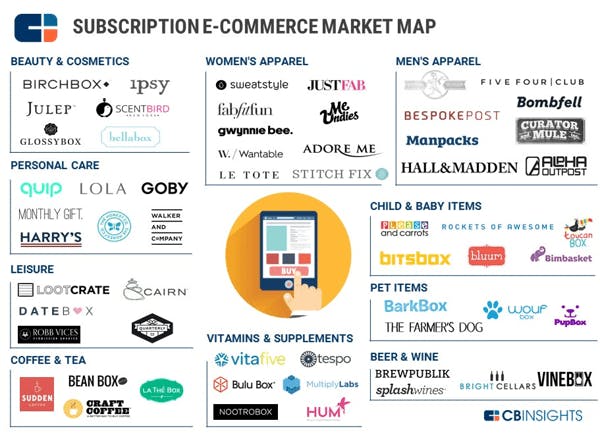
Subscription ecommerce market map via CB Insights.
When you’re performing this analysis, understanding how the existing competitors in your market are currently positioned can also help you refine your available audience.
Figure out your target audience
Relationships are at the core of the subscription model. During the research stage of the process, it’s important to nail down exactly who your potential customers might be. You need to tailor your product, your positioning, and your marketing strategy to their needs.
Once you’ve put in the time to do your research, it will be much easier to formulate concrete and attainable goals for your subscription business.
2. Determine your business goals
Whether it’s a revenue number, a customer acquisition benchmark, or the number of units sold, understanding what you want to get out of your business is paramount.
Setting these goals early on also gives you something to strive for and measure against. For example, if your goal was to achieve an MRR of $40,000 by the end of Q4 2020, you can plot out how much your company needs to grow each month to get there.
Make sure to break down objectives into both long-term and short-term goals whether you're a tech company or a SaaS business. The short term ones will help you feel like you’re accomplishing something as you make headway toward your larger, long-term goals.
For more ideas, check out these 180+ goals for every role in tech!
With your goals in place, it’s time to start thinking about what kind of customers will help you attain each goal.
3. Define your buyer personas
Buyer personas are an essential tool for building a subscription business. They help you find the potential customers who are the most interested in your product and will be willing to pay once it launches. Take these examples from our PriceIntelligently blog:
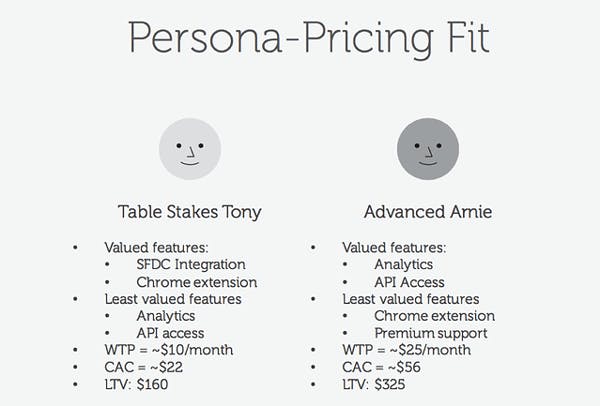
Two examples of basic buyer personas.
As you can see, there’s a lot of valuable information to help refine your targeting strategy. Building these personas starts with a bit more research.
Collect data
Take a look at the data you collected on target audiences during the research step, and start segmenting it. Identify the specific characteristics of potential customers, and think about how to target them. The more data you have, the more specific you can be when building your personas.
Conceptualize three to five buyer personas
One buyer personas won’t cut it; you should have a few options to choose from. That makes targeting each persona with specific pricing, features, and marketing easier because you understand their needs.
Break down these buyer personas by demographics like age and income. Once you have the basic concepts down, you can start adding in more data on these personas’ desired features and willingness to pay (WTP).
Build targeting strategies
Analyze the similarities and differences between your buyer personas to determine how they should be targeted. One way to segment your personas is by WTP, which can help you find the optimal pricing structure to fit their needs.
Understanding who your target personas are also helps you build a more actionable marketing strategy. That process starts with defining your core value proposition, which we talk about in the next section.
Create your value proposition
Your value proposition communicates the most attractive aspects of your product or service to potential customers. Nailing your value proposition makes it easier for potential customers to see how useful your product or service is and helps you justify the price you set for it.
Take the subscription box Dollar Shave Club, for example. Its core value proposition is simple:Quality razors at budget prices, delivered directly to the customer.
If your value proposition isn’t clear, you’ll be leaving potential customers on the table for your competitors. Here are a few rules to follow:
- Explain value for customers. Be clear with exactly how your product or service provides value. Use numbers if you have them.
- Highlight your differentiators. Your value proposition has to communicate why potential customers should choose you over your competitors.
- Motivate prospective customers to learn more. Value propositions need to be enticing; your goal is to draw people in to learn more.
With your core value proposition set, you have the core message you want to present to customers. From there, it’s finally time to take your product or service to the customers.
Test your new subscription with a beta launch
Now that you’ve done all the requisite market and customer research, it’s time to test out your go-to-market strategy in earnest. One of the best ways to do this is with a beta launch. You’ll be able to gather valuable feedback from potential customers.
After participating in the beta launch, people will have a more emotional connection with your product or service. That kind of connection can be the basis of a longer-lasting relationship with your customers.
Your beta launch should essentially consist of three main goals:
- Find people to use your product.Look for users who fit into your buyer personas. You want to get feedback from the type of people who might become actual customers.
- Ask questions.
- Make changes based on input.
Beta tests can also be a great way to pique interest in an upcoming release. Not only will you be able to talk about the beta test with your potential customers, but the testers themselves will share their experiences with their networks. When you capture that feedback during the survey process, you can use it as social proof in your marketing too.
Your beta launch can also be a great time to gain insight on potential pricing strategies. Your beta customers will definitely have feedback on what they’re willing to pay.
Build a value-based pricing structure
Subscription works best with value-based pricing because it helps you monetize the facet of your company that customers perceive as the most valuable. Because customer relationships are at the core of the subscription model, this type of pricing ensures that you’re focusing on the right thing.
The first step of setting this pricing is nailing down your value metric. This is another point in the process where Price Intelligently can help—we have a team of pricing experts to guide you toward the right metric.
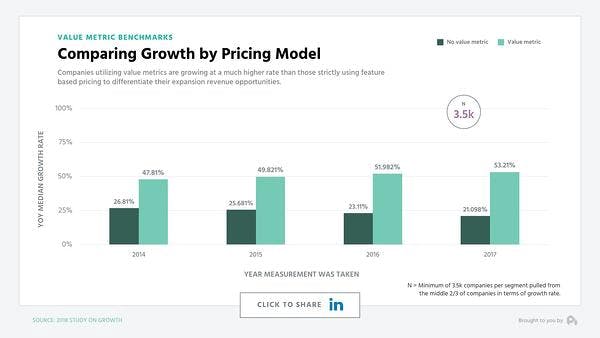
Companies with a value metric tend to grow faster than those without one.
Once you’ve determined your value metric, start creating your pricing tiers based on feature differentiation. Build tiers that not only maximize your revenue potential based on the value metric but also appeal to your customer personas’ needs and willingness to pay.
Just remember that pricing isn’t a set-it-and-forget-it type of situation. You should always be evaluating and testing your pricing as your company grows. Changes to your product or service as well as changes in customers and market conditions affect buyers’ willingness to pay.
Use a reliable subscription billing system
Subscription billing management has the potential for complexity because you’re monetizing recurring customer relationships. Choosing the right subscription management platform ensures you can reliably capture revenue from your customers.
Regardless of the platform you’re using to receive and process payments, it’s important to make the billing process as seamless as possible. This can be difficult when there are six different functions your subscription management platform can perform.
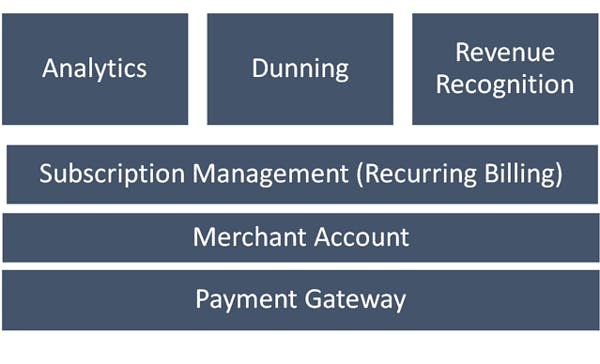
Different facets of subscription billing.
To help you get started, we’ve put together an overview of our top 23 subscription providers. Choosing the best fit for your company will clear up confusion for your customers and drive down the potential for delinquent churn.
Analyze metrics and evaluate your position
To be successful, subscription companies rely on ongoing relationships with customers. If you’re not regularly checking in on these relationships across a number of metrics, you’re setting yourself up to fail. With a platform like ProfitWell Metrics, you’re able to gain a better understanding of the overall health of your business.
Know which metrics to track
When you track various metrics, such as MRR, LTV, churn rate, and retention rate, you get a better understanding of the overall financial heath of your business.
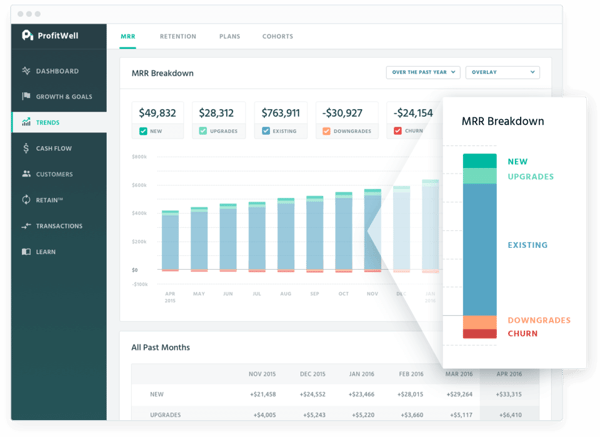
Example MRR Breakdown.
Being able to visualize how your MRR grows over time or how your overall revenue growth is affected by churn helps you make smarter decisions regarding your company growth. Whether you’re tracking your sales pipeline or trying to get a better handle on why certain customers leave, metrics help.
Gain insight into customer value
To reevaluate your product or pricing strategy, survey current customers to learn how you can serve them better. Getting this qualitative feedback is one of the most powerful growth levers you have because it provides exactly the context that you need to make changes to proactively address issues.
Whether it’s a simple SurveyMonkey poll, a quick email asking for feedback, or a direct conversation on the phone, communicating with your customers is one of the best ways to learn more about the state of your product.
By combining this quantitative and qualitative data, you’re creating a more well-rounded picture of both your company’s successes and your company’s failures. From there, you can start thinking about how to make adjustments to your strategy.
Prioritize retention
Being able to retain customers while also bringing in new ones helps you build a solid base to scale your company. This is especially important for a subscription company because every customer lost to churn is a direct hit to revenue. That’s why subscription companies need a concrete understanding of what drives their customer churn.
Actively working toward reducing churn doesn’t have to be a complicated process with. Using our tool helps you analyze retention, automate retention efforts, and give your team more time to focus on building an awesome product experience.
We’ve also put together a comprehensive guide that goes over the different strategies you can use for identifying, calculating, and reducing churn. Each tactic works together to help you boost retention rates across your customer base.
When you prioritize retention, it helps you get more into the mind-set that customers are at the core of the subscription model and that your actions affect the customer relationship.
Creating a subscription service starts with the customer
With the customer at the core of every decision you make, you’re positioning your subscription company to grow. As you’re building your business, always remember that maintaining these relationships is the key to your success.
By following these nine steps, you’ll be encouraged to keep your target customer top of mind, leading to a better understanding of how to create a subscription service.


